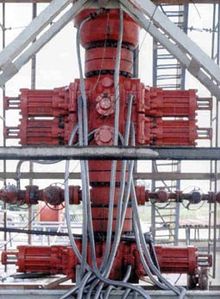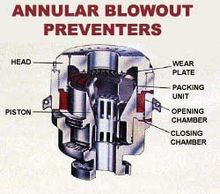Blowout Preventer
A blowout preventer (BOP for short) is a series of shut-off valves that are installed directly above the borehole in an oil or gas well and that (mainly) serve to prevent a blowout .
The blowout preventer is the central safety element in deep drilling . The designation refers both to the individual shut-off devices and to their combination to form the BOP stack ( 'BOP stack' ). This arrangement of stacked BOP steps can be over 10 meters high and weigh more than 200 tons. The BOP valves are operated by powerful hydraulics . The use of several valves also means a redundant design with regard to high functional reliability.
The blowout preventer is installed directly above the borehole. When drilling underwater, it is on the seabed.
function
If a blowout threatens while the drill string is running through the BOP, the first thing to do is to activate slides, which are shaped to encircle the drill pipe or borehole casing and thus seal the annulus , the outer space.
The annular BOP fulfills the same purpose , in which an annular rubber element, which is compressed in the longitudinal direction, seals the space between the drill pipe and the inner wall of the BOP. The annular BOP is also used to seal the borehole during pressure measurements.
Should these mechanisms fail, there is another safety device: A stage of slides with hardened cutting edges ( 'shear rams' ) is intended to cut the entire pipe rod through the BOP and thus ensure the seal under all circumstances. If the BOP is free of continuous pipes, the 'shear rams' can also serve as normal gate valves.
Depending on the area of application, blowout preventers are subjected to function tests at different time intervals.
Often oil disasters are closely related to a failure of the BOP.
conditions
Blowout preventers are products at the limit of the design for the loads to be expected.
Technical articles have often questioned whether BOPs are actually strong enough to cut the drill string. A 2004 study commissioned by American federal agencies found that only 3 out of 14 oil platforms had sufficiently strong BOP shear stages.
In particular, the 'shear rams' are not necessarily designed to be able to cut the drill pipe at its connecting elements.
Kill lines
The structure of a BOP can contain 'kill lines' - junctions for "shooting in" heavy drilling fluid to create stable pressure conditions in the borehole ( top kill operation).
additional
After completing a well it is optionally provided with a construction simpler shut-off devices, the so-called christmas tree ( 'Christmas tree').
Web links
- mrtopf.de: "BP Oil Disaster: How a Blowout Preventer Works (or Does n't)"
Individual evidence
- ↑ spiegel.de: Exploded Oil Platform - Drilling to Break , May 1, 2010.
- ↑ can be supported by a "servo effect" via the upcoming borehole pressure ( Cameron BOP product description ( Memento of the original from June 7, 2010 in the Internet Archive ) Info: The archive link was inserted automatically and has not yet been checked. Please check the original and archive link accordingly Instructions and then remove this notice. ).
- ^ Schlumberger: Oil field glossary - blowout preventer .
- ↑ Der Tagesspiegel: No plumber would install such nonsense , May 5, 2010.
- ^ The Wall Street Journal: Disaster Plans Lacking at Deep Rigs (interactive graphics), May 18, 2010 (accessed May 20, 2010).
- ^ The Wall Street Journal: Disaster Plans Lacking at Deep Rigs (article), May 18, 2010.
- ↑ The Oil Drum: Structure of a BOP with functional description .



